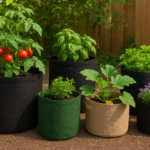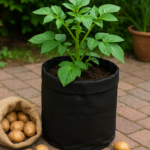The Philodendron Red Anderson has gained popularity among plant lovers and interior decorators with its eye-catching allure and manageable care requirements. Its presence can transform any space into a green oasis, creating a calming and inviting atmosphere.
Whether you’re an experienced plant enthusiast or just starting your journey with houseplants, the Philodendron Red Anderson will surely captivate you with its charm. Explore its beauty, care for it diligently, and enjoy the rewarding experience of having this remarkable plant as part of your indoor garden.
What is Philodendron Red Anderson?
The Philodendron Red Anderson is a captivating plant known for its striking appearance and vibrant foliage. With its deep red hues and glossy leaves, it effortlessly adds a touch of elegance to any indoor space.
Native to the tropical rainforests of South America, particularly Brazil, this Philodendron variety thrives in warm and humid environments. Its unique coloration is a result of anthocyanin pigments, which give the leaves their rich red hue.
The Philodendron Red Anderson is not only aesthetically pleasing but also offers health benefits. Like other houseplants, it helps to purify the air in your home or office.
Philodendron Red Anderson vs. Pink Princess: Contrasting Beauties
Philodendron Red Anderson and Pink Princess are two captivating varieties that belong to the Philodendron genus.
While they share the same plant family and have a few similarities, they also possess distinctive characteristics that set them apart.
Let’s explore the unique qualities of both plants and delve into their differences.
Philodendron Red Anderson: A Symphony of Red
Philodendron Red Anderson is renowned for its deep red foliage, which instantly grabs attention and adds a touch of elegance to any space. Its heart-shaped leaves showcase a vibrant red coloration that can vary depending on the plant’s age and environmental conditions.
The glossy texture of the leaves enhances its visual appeal, reflecting light beautifully. This variety is known for its climbing habit, making it an excellent choice for vertical displays or hanging baskets.
With proper care, Philodendron Red Anderson can grow vigorously, transforming its surroundings into a tropical paradise. Its stunning red foliage and graceful growth pattern makes it a popular choice among plant enthusiasts.
Contrasting Characteristics
While both Philodendron Red Anderson and Pink Princess are captivating in their own right, they do have a few contrasting characteristics:
- Coloration: Red Anderson features deep red leaves, while Pink Princess exhibits a combination of pink, green, and white variegation.
- Growth Patterns: Red Anderson tends to have larger leaves and a more uniform growth habit, while Pink Princess may have smaller leaves and a more vining growth habit.
- Availability and Price: Pink Princess is often considered rare and harder to find compared to Red Anderson, making it generally more expensive.
Red Anderson Philodendron Care: Nurturing the Beauty
To ensure the optimal health and vibrant coloration of your Red Anderson, it’s essential to provide it with the right care and attention. Follow this comprehensive care guide to nurture the beauty of your Philodendron Red Anderson:
Light Requirements
Place your Philodendron Red Anderson in a location that receives bright, indirect light. While it can tolerate lower light conditions, providing it with ample bright light will promote robust growth and maintain the vividness of its red leaves. Avoid direct sunlight, as it can scorch the foliage.
Temperature
Philodendron Red Anderson prefers average to warm temperatures between 65-85°F (18-29°C). Avoid exposing it to sudden temperature fluctuations and drafty areas. Protect the plant from cold drafts, as exposure to cold air can cause damage to the foliage. Keep it away from heating vents or radiators, as direct heat can dry out the plant. Maintaining temperature within its preferred range helps promote healthy growth and prevents stress.
Indoors, Philodendron Red Anderson can thrive in average room temperatures, typically ranging from 68°F (20°C) to 75°F (24°C). Avoid placing the plant near drafty windows, air conditioning units, or heating vents, as these can expose it to temperature fluctuations.
If you choose to grow Philodendron Red Anderson outdoors, ensure that the temperatures are within the preferred range.
Watering
Keep a balance when watering your Philodendron Red Anderson. Aim to keep the soil consistently moist but not waterlogged. Overwatering can lead to root rot, while underwatering may cause the leaves to wilt. Allow the top inch of soil to dry out slightly before watering again. Adjust the watering frequency based on the environmental conditions and the plant’s needs.
Humidity
Philodendron Red Anderson thrives in moderate to high humidity. It prefers humidity levels between 50% and 70%.
Use a humidifier or place a tray with water and pebbles at the bottom of the container to boost the humidity surrounding the plant. A humid environment is produced around the plant as a result of the water evaporation.
Regular misting of the leaves with water can also help provide some humidity. However, ensure that the plant is not constantly wet, as excessive moisture can lead to fungal diseases.
Soil
Philodendron Red Anderson thrives in well-draining soil that retains some moisture. A combination of peat moss, perlite, and orchid bark works well to ensure proper drainage while retaining some moisture. This mixture helps provide good drainage while retaining enough moisture for the plant’s roots. Avoid using heavy or compacted soil that may lead to waterlogged conditions.
Fertilization
Feed your Philodendron Red Anderson with a balanced liquid houseplant fertilizer during the growing season (spring and summer). Apply the fertilizer every two to four weeks after diluting it in accordance with the provided instructions. This will provide the necessary nutrients to support healthy growth and vibrant foliage.
Pruning Philodendron Anderson
Regular pruning helps maintain the appearance and health of your Philodendron Red Anderson. Remove any yellowing or damaged leaves promptly to encourage new growth. Trimming back leggy vines also promotes bushier growth.
Use clean, sharp pruning shears or scissors to make clean cuts just above a leaf node. Pruning can be done throughout the year as needed. Always sanitize your pruning tools before use to prevent the spread of diseases.
Support and Training
As Red Anderson matures, it tends to develop a climbing habit. Provide a moss pole, trellis, or other support structures for the plant to climb on. This not only enhances the aesthetics but also helps the plant grow vertically, showcasing its beautiful foliage.
Pot Size: Choosing the Right Home
Selecting an appropriate pot size is essential for the growth and development of your Philodendron Red Anderson.
When choosing a pot, consider the current size of the plant’s root system.
A pot that allows for some growth without being excessively large is ideal.
Opt for a container that provides a few inches of space around the roots, allowing them to expand gradually.
Drainage: Essential for Healthy Roots
Proper drainage is essential for the healthier and bushier growth of your plant.
Ensure that your chosen pot has drainage holes at the bottom to allow excess water to pass away.
Placing a layer of pebbles or broken pottery shards at the bottom of the pot can enhance drainage by preventing the soil from blocking the drainage holes.
Potting: Creating the Ideal Growing Medium
When potting your Philodendron Red Anderson, it’s important to use a suitable growing medium. A well-draining potting mix is ideal, providing a balance of moisture retention and proper aeration. A mix containing peat moss, perlite, orchid bark, or other organic matter works well. Avoid using heavy or compacted soils, as they can hinder drainage and lead to root issues.
To pot your Philodendron Red Anderson, gently remove it from its current container, taking care not to damage the roots. Make sure the soil level is the same depth as before and set the plant in the center of the new pot.
Fill in the gaps with the potting mix, gently firming it around the roots. Avoid packing the soil too tightly, as it can hinder proper root growth.
Repotting Philodendron Red Anderson
As your Philodendron Red Anderson grows, it will eventually outgrow its current pot. Repotting allows for fresh soil, more space for root expansion, and continued growth. Here are some guidelines for repotting:
- Timing: Repot your Philodendron Red Anderson when you notice that the roots have become pot-bound, meaning they have filled the current pot and are tightly packed. This is usually evident when you see roots emerging from the drainage holes or circling around the root ball.
- Repotting Technique: Gently remove the plant from its current pot, carefully loosening the roots. If the roots are tightly bound, you can tease them apart slightly to encourage outward growth. Choose a new pot that is slightly larger in size, following the potting guidelines mentioned earlier. Place the plant in the new pot, fill it in with fresh potting mix, and firm it gently around the roots. Water the plant lightly after repotting to settle the soil.
- Monitoring and Maintenance: After potting or repotting your Philodendron Red Anderson, monitor its condition closely. Ensure that the soil remains moist but not waterlogged, adjusting your watering routine as needed. Regularly check the drainage holes to ensure they are not clogged and that water can flow freely.
You may also like Philodendron Red Sun Care Guide
Philodendron Red Anderson Propagation
Propagating Philodendron Red Anderson is an exciting way to expand your plant collection and share the beauty of this stunning variety with others. With the right techniques, you can successfully propagate your Red Anderson and enjoy the satisfaction of nurturing new plants. Let’s explore the different methods of propagating Philodendron Red Anderson:
Stem Cuttings
Stem cuttings are the most common and reliable method of propagating Philodendron Red Anderson. Here’s how to do it:
- Select a healthy stem with at least two nodes (the points where leaves emerge). Nodes are essential for root development.
- Using clean and sharp pruning shears or a sharp knife, make a clean cut just below a node. This will be the base of your cutting.
- Remove any lower leaves, leaving a few leaves at the top for photosynthesis.
- Place the cutting in a glass of water, ensuring that the lower node is submerged.
- Position the cutting in a warm location with indirect light. Avoid direct sunlight, as it can scorch the delicate cutting.
- Change the water every few days or ensure the potting mix remains slightly moist. Roots should begin to develop within a few weeks.
- When the roots get approximately 1-2 inches long, transplant the cutting into a small pot with a well-draining potting mix. Ensure the roots are covered.
- Place the newly potted cutting in a location with bright, indirect light and continue to care for it as you would for a mature Philodendron Red Anderson.
Air Layering
Air layering is another method that can be used to propagate Philodendron Red Anderson. This technique involves creating a rooting area on a mature stem while it is still attached to the parent plant. Here’s a simplified step-by-step process:
- Select a healthy stem and locate a section where you want to create the air layer.
- Make a 1-2 inch vertical incision in the stem, exposing the inner tissue.
- Dust the exposed area with rooting hormone to encourage root development.
- Take a handful of moist sphagnum moss and wrap it around the incision, ensuring it remains in place.
- Cover the moss with plastic wrap to create a sealed environment and secure it with tape or a rubber band.
- Monitor the moss regularly, ensuring it remains moist but not waterlogged.
- Within a few weeks or months, roots should form within the moss.
- Once the roots are well-developed, carefully remove the air layer from the parent plant and pot it in a suitable container with a well-draining potting mix.
Division
Air layering is another method that can be used The division is a method suitable for mature Philodendron Red Anderson plants with multiple stems or offshoots.
- Carefully remove the parent plant from its pot, taking care not to damage the root system.
- Gently separate the plant into two or more sections, ensuring each division has an adequate number of roots and stems.
- Trim any damaged or unruly roots, if necessary.
- Plant each division into separate pots with fresh potting mix, ensuring the roots are covered and supported.
- Provide proper care, including appropriate lighting, watering, and humidity, to help the divided plants establish themselves.
Remember that propagating Philodendron Red Anderson from seeds requires more time, effort, and patience compared to other methods. It is a fascinating process that allows you to observe the complete life cycle of the plant, from seed to mature specimen.
Common Leaf Issues in Philodendron Red Anderson
As much as we adore our Philodendron Red Anderson plants, they can sometimes encounter leaf issues that require our attention. Let’s explore some of the most common leaf issues in Philodendron Red Anderson, their potential causes, and possible solutions:
Yellowing Leaves
Yellowing leaves in Philodendron Red Anderson can be attributed to various factors, including overwatering, underwatering, nutrient deficiencies, or exposure to direct sunlight.
Evaluate your watering routine and adjust it accordingly, allowing the top inch of soil to dry out before watering again. Ensure your plant is receiving adequate but indirect sunlight. Consider fertilizing with a balanced houseplant fertilizer to address nutrient deficiencies.
Brown Spots or Leaf Edges
Brown spots or leaf edges are often a result of inconsistent watering practices, underwatering, or low humidity levels. It can also be caused by excess salts in the soil.
Maintain a consistent watering schedule, allowing the soil to slightly dry out between waterings. Increase humidity levels by misting the leaves or placing a humidifier nearby. Consider flushing the soil with water to remove excess salts or repotting the plant using fresh, well-draining soil.
Leaf Curling
Leaf curling in Philodendron Red Anderson can be caused by environmental stressors, such as low humidity, excessive heat, or exposure to drafts.
Increase humidity levels around the plant by misting the leaves regularly or placing a tray of water nearby. Protect the plant from direct drafts or extreme temperature fluctuations. Check for signs of pests, such as mealybugs or spider mites, and treat the plant accordingly using appropriate organic methods.
Leaf Spotting or Discoloration
Leaf spotting or discoloration can be caused by fungal or bacterial infections, nutrient deficiencies, or exposure to cold drafts.
Remove any affected leaves to prevent the spread of infection. Adjust watering practices to ensure the soil is not consistently wet. Maintain proper air circulation around the plant. Consider applying a fungicide or bactericide if the issue persists. Fertilize the plant with a balanced houseplant fertilizer to address nutrient deficiencies.
Wilting Leaves
Wilting leaves can be a sign of both overwatering and underwatering. Overwatering can lead to root rot and suffocation, while underwatering can cause dehydration and nutrient uptake issues.
Check the moisture level of the soil and adjust the watering accordingly. Ensure the pot has proper drainage to prevent waterlogging. Consider repotting the plant using well-draining soil. Trim any affected roots if root rot is suspected.
Leaf Drop
Leaf drops can occur due to environmental changes, such as temperature fluctuations, low humidity, or a sudden change in light conditions. It can also result from overwatering or underwatering.
Provide stable environmental conditions for your plant, avoiding extreme temperature changes and drafts. Increase humidity levels by using a humidifier or placing a tray of water nearby. Ensure proper watering practices by allowing the soil to dry out slightly between waterings.
Pests and Diseases of Philodendron Red Anderson
While Philodendron Red Anderson is generally a resilient and hardy plant, it can still fall victim to pests and diseases. Let’s explore some of the most common pests and diseases that can impact Philodendron Red Anderson and learn how to manage them effectively:
Pests
Aphids
Aphids are small, soft-bodied insects that can gather new growth, causing curling and distortion. They can be found clustered on new growth, undersides of leaves, or along stems.
Use a strong stream of water to wash off aphids from the plant. Alternatively, you can apply insecticidal soap or neem oil following the product instructions. Repeat treatments may be necessary to fully eliminate the infestation.
Spider Mites
Spider mites are tiny pests that can cause webbing on the leaves and damage the plant by piercing the cells and sucking out the sap.
Regularly misting the leaves to increase humidity can help deter spider mites. If an infestation occurs, you can use insecticidal soap, neem oil, or horticultural oil following the product instructions. Ensure thorough coverage, targeting the undersides of leaves.
Mealybugs
Mealybugs are small, cotton-like insects that gather in clusters. They can be found on leaf joints, leaf undersides, and along stems. Infested areas may appear white or have a sticky residue.
Remove mealybugs manually using a cotton swab dipped in rubbing alcohol or soapy water. For severe infestations, you can use insecticidal soap or neem oil following the product instructions.
Scale Insects
Scale insects are small, oval-shaped pests that attach themselves to the plant and form a protective shell. They can be brown, black, or tan in color and often appear as raised bumps on leaves or stems.
Gently scrape off-scale insects using a soft brush or your fingernail. You can also use insecticidal soap or neem oil following the product instructions. Repeat treatments may be necessary to target newly hatched scales.
Diseases
Leaf Spot
Leaf spot diseases are fungal or bacterial infections that cause spots or lesions on the leaves. The spots may vary in color, including brown, black, or yellow, and can sometimes have a concentric ring pattern.
Remove and destroy any infected leaves to prevent the spread of the disease. Ensure proper air circulation and avoid overhead watering to minimize moisture on the foliage. Applying a fungicide or bactericide following the product instructions can help manage severe cases.
Root Rot
Root rot is caused by overwatering or poorly draining soil, leading to the decay of the plant’s roots. Symptoms include wilting, yellowing leaves, and a foul odor from the soil.
Address root rot by improving drainage conditions. Allow the soil to dry out slightly between waterings and ensure the pot has adequate drainage holes. Trim any affected roots and repot the plant using fresh, well-draining soil.
By staying vigilant and taking prompt action when necessary, you can effectively manage and mitigate pest and disease issues in your beloved Philodendron Red Anderson, ensuring its continued health and vibrancy. Is
Is Philodendron Red Anderson toxic?
Yes, Philodendron Red Anderson, like many other members of the philodendron genus, is toxic to humans and pets if ingested. It contains calcium oxalate crystals and causes irritation and discomfort when chewed or swallowed. When the mouth, throat, and digestive systems are irritated by the crystals, it creates symptoms like swelling and burning.
It is important to keep Philodendron Red Anderson, out of reach of children and pets to prevent accidental ingestion.
It is advised to seek medical assistance or call a poison control center right away if you believe someone has consumed any component of the plant or is showing symptoms after contact.
While Philodendron Red Anderson adds beauty to indoor spaces, it is essential to handle it with care and be aware of its toxic nature to ensure the safety of everyone in the household, including curious pets.
Where to Buy Philodendron Red Anderson
If you want to buy Philodendron Red Anderson, you can purchase it both online and offline. Here several options are available to you:
Local Plant Nurseries
Visit your local plant nurseries or garden centers. They may have Philodendron Red Anderson in stock or be able to order it for you.
Online Plant Retailers
Explore online plant retailers that specialize in rare and exotic plants. Websites like Etsy, Amazon, eBay, and specialized plant shops often offer a variety of Philodendron Red Anderson plants for purchase.
Plant Enthusiast Groups
Join online plant enthusiast groups or forums on social media platforms. These communities often have members who trade, sell, or propagate Philodendron Red Anderson plants.
Plant Expos or Farmers’ Markets
Check for plant expos or farmers’ markets in your area. These events can be great places to find unique plant varieties, including Philodendron Red Anderson.
Remember to read reviews, check seller ratings, and ensure that the plants are sourced ethically and shipped with care. Always choose reputable sellers to ensure the quality and health of your Philodendron Red Anderson plant.
FAQs
Q: What is Philodendron Red Anderson?
A: Philodendron Red Anderson is a specific cultivar of the Philodendron genus, known for its attractive deep red foliage. It is a tropical plant that thrives in warm and humid environments, making it a popular choice among indoor plant enthusiasts.
Q: What’s the difference between a Red Anderson and a Pink Princess?
A: The main difference lies in their foliage colors. Philodendron Red Anderson features deep red leaves, while Pink Princess showcases a combination of green and pink variegated foliage. They have distinct appearances but require similar care in terms of light, water, and humidity.
Q: How do you care for a Red Anderson plant?
A: To care for a Red Anderson plant, provide bright indirect light, keep the soil evenly moist (but not soggy), maintain high humidity levels, and avoid exposing it to temperature extremes. Regularly dust the leaves, fertilize during the growing season, and repot as needed. Remember to follow specific care instructions for the best results.
Q: What is a Red King Philodendron?
A: Red King Philodendron is another cultivar of the Philodendron genus. It features large, glossy leaves with a vibrant red hue. It’s a visually striking plant that adds a pop of color to any indoor space. Similar to other Philodendrons, it requires warm conditions, bright indirect light, and appropriate watering.
Q: How do you take care of a Red Philodendron?
A: To care for a Red Philodendron, provide bright indirect light, and water when the top inch of soil feels dry, maintain moderate humidity, and avoid temperature extremes. Regularly dust the leaves, fertilize during the growing season, and repot when necessary. Following these care guidelines will help ensure the health and vitality of your Red Philodendron plant.
Q: Is Red Anderson are?
A: Yes, Red Anderson is considered a relatively rare cultivar of Philodendron. Its distinctive deep red foliage and unique appearance make it highly sought after by plant enthusiasts and collectors.
Q: What is the scientific name of Red Anderson?
A: The scientific name of Red Anderson is Philodendron ‘Red Anderson’. It is a cultivar or hybrid of the Philodendron genus, specifically bred for its striking red foliage coloration.
Conclusion
Philodendron Red Anderson is a captivating cultivar that brings a touch of tropical beauty to any indoor or outdoor space. Throughout this guide, we have explored various aspects of caring for Philodendron Red Anderson, including its characteristics, propagation, care tips, and potential challenges.
From this comprehensive guide, you have learned how to cultivate and nurture Philodendron Red Anderson. By following these care guidelines, you can provide the ideal growing conditions for your Philodendron Red Anderson, ensuring its longevity and allowing its vibrant red foliage to enchant your indoor space for years to come.
Happy gardening!







